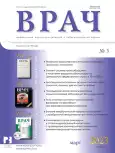Дифференциальная диагностика мочевых камней разного химического состава с использованием двухэнергетической компьютерной томографии
- Авторы: Рязанов В.В.1, Куценко В.П.1, Садыкова Г.К.1, Меньшикова С.В.1, Селиверстов П.В.2, Багненко С.С.1,2, Николаев А.В.1, Постаногов Р.А.1, Либерт А.А.1
-
Учреждения:
- Санкт-Петербургский государственный педиатрический медицинский университет Минздрава России
- Военно-медицинская академия им. С.М. Кирова
- Выпуск: Том 34, № 3 (2023)
- Страницы: 43-48
- Раздел: Для диагноза
- URL: https://journals.eco-vector.com/0236-3054/article/view/364521
- DOI: https://doi.org/10.29296/25877305-2023-03-08
- ID: 364521
Цитировать
Полный текст
Аннотация
Применение двухэнергетической компьютерной томографии (ДЭКТ) получило широкое распространение в урологии, в том числе в диагностике уролитиаза. Благодаря использованию ДЭКТ удается визуализировать и дифференцировать друг от друга мочевые камни разной химической плотности и композиции. Исследования показали преимущества ДЭКТ не только в обнаружении, но и в дифференцировке основных групп мочевых камней. При этом в ряде исследований in vivo ДЭКТ оценивается как способ высокоточной дифференциальной диагностики уратных камней. Точность диагностики уратных камней при ДЭКТ достигает 92–100%, что подтверждается показателями чувствительности (84,6–98,4%) и специфичности (100%).
Полный текст
Об авторах
В. В. Рязанов
Санкт-Петербургский государственный педиатрический медицинский университет Минздрава России
Автор, ответственный за переписку.
Email: val9126@mail.ru
доктор медицинских наук
Россия, Санкт-ПетербургВ. П. Куценко
Санкт-Петербургский государственный педиатрический медицинский университет Минздрава России
Email: val9126@mail.ru
кандидат медицинских наук
Россия, Санкт-ПетербургГ. К. Садыкова
Санкт-Петербургский государственный педиатрический медицинский университет Минздрава России
Email: val9126@mail.ru
кандидат медицинских наук
Россия, Санкт-ПетербургС. В. Меньшикова
Санкт-Петербургский государственный педиатрический медицинский университет Минздрава России
Email: val9126@mail.ru
Россия, Санкт-Петербург
П. В. Селиверстов
Военно-медицинская академия им. С.М. Кирова
Email: val9126@mail.ru
кандидат медицинских наук
Россия, Санкт-ПетербургС. С. Багненко
Санкт-Петербургский государственный педиатрический медицинский университет Минздрава России; Военно-медицинская академия им. С.М. Кирова
Email: val9126@mail.ru
доктор медицинских наук
Россия, Санкт-Петербург; Санкт-ПетербургА. В. Николаев
Санкт-Петербургский государственный педиатрический медицинский университет Минздрава России
Email: val9126@mail.ru
Россия, Санкт-Петербург
Р. А. Постаногов
Санкт-Петербургский государственный педиатрический медицинский университет Минздрава России
Email: val9126@mail.ru
Россия, Санкт-Петербург
А. А. Либерт
Санкт-Петербургский государственный педиатрический медицинский университет Минздрава России
Email: val9126@mail.ru
Россия, Санкт-Петербург
Список литературы
- Зуева Л.Ф., Капсаргин Ф.П., Симонов К.В. Метафилактика камней почек на основе компонентного состава, выявленного методами ДЭКТ и КЭ. Медицина и высокие технологии. 2020; 1: 55–67.
- Капанадзе Л.Б., Серова Н.С., Руденко В.И. и др. Опыт применения двухэнергетической компьютерной томографии у пациента с мочекаменной болезнью. Медицинская визуализация. 2018; 4: 59–64. doi: 10.24835/1607-0763-2018-4-59-64
- Капанадзе Л.Б., Серова Н.С., Руденко В.И. и др. Результаты применения двухэнергетической компьютерной томографии в диагностике мочекаменной болезни. REJR. 2018; 8 (2): 94–104. doi: 10.21569/2222-7415-2018-8-2-94-104
- Назаров Т.Х., Рычков И.В., Лебедев Д.Г. и др. Сравнительный анализ данных двухэнергетического компьютерного томографа и результатов минералогического исследования мочевых камней при уролитиазе. Лучевая диагностика и терапия. 2018; 2: 54–8. doi: 10.22328/2079-5343-2018-9-2-54-58
- Лопаткин Н.А. Урология. Под ред. Н.А. Лопаткина. М.: ГЭОТАР-Медиа, 2011; 1024 с..
- Appel E., Thomas C., Steuwe A. et al. Evaluation of split-filter dual-energy CT for characterization of urinary stones. Br J Radiol. 2021; 94 (1127): 20210084. doi: 10.1259/bjr.20210084
- Erdogan H., Temizoz O., Koplay M. et al. In Vivo Analysis of Urinary Stones With Dual-Energy Computed Tomography. J Comput Assist Tomogr. 2019; 43 (2): 214–9. doi: 10.1097/RCT.0000000000000831
- McGrath T.A., Frank R.A., Schieda N. et al. Diagnostic accuracy of dual-energy computed tomography (DECT) to differentiate uric acid from non-uric acid calculi: systematic review and meta-analysis. Eur Radiol. 2020; 30: 2791–801. doi: 10.1007/s00330-019-06559-0
- Nourian A., Ghiraldi E., Friedlander J.I. Dual-Energy CT for Urinary Stone Evaluation. Curr Urol Rep. 2021; 22 (1): 1. doi: 10.1007/s11934-020-01019-5
- Ogawa N., Sato S., Ida K. et al. Evaluation of Urinary Stone Composition and Differentiation between Urinary Stones and Phleboliths Using Single-source Dual-energy Computed Tomography. Acta Med Okayama. 2017; 71 (2): 91–6. doi: 10.18926/AMO/54976
- Rompsaithong U., Jongjitaree K., Korpraphong P. et al. Characterization of renal stone composition by using fast kilovoltage switching dual-energy computed tomography compared to laboratory stone analysis: a pilot study. Abdom Radiol. 2019; 44: 1027–32. doi: 10.1007/s00261-018-1787-6
- Shalini S., Kasi Arunachalam V., Kumar Varatharajaperumal R. et al. The role of third-generation dual-source dual-energy computed tomography in characterizing the composition of renal stones with infrared spectroscopy as the reference standard. Pol J Radiol. 2022; 87 (1): 172–6. doi: 10.5114/pjr.2022.114841
Дополнительные файлы









